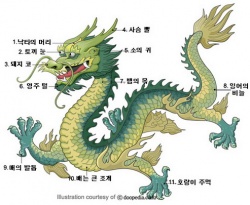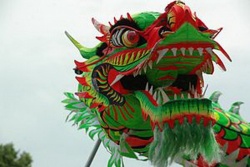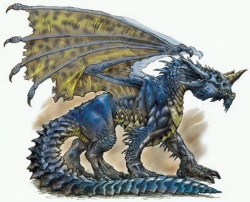Difference between revisions of "Tianlong, the Celestial Dragons"
Jump to navigation
Jump to search
| Line 1: | Line 1: | ||
[[File:12jan dragon.jpg|thumb|250px|]] | [[File:12jan dragon.jpg|thumb|250px|]] | ||
| − | :: Dragon cultures exit in both the Eastern and Western | + | :: Dragon cultures exit in both the Eastern and Western [[World]]. [[Dragons]] are deeply rooted in Chinese culture, so Chinese often consider themselves, 'the descendants of the dragon.' In the Western, [[Dragons]] can be found in many literatures and they look significantly different from the [[Chinese dragon]]. We will focus on the [[Chinese dragon]] here. |
:: | :: | ||
| − | ::Nobody really knows where the dragon comes from. The dragon looks like a combination of many | + | ::Nobody really knows where the dragon comes from. The dragon looks like a combination of many [[Animals]], such as a reptile, a snake, an alligator, and a lizard. Or it may be just a product from the imagination of Chinese people. |
:: | :: | ||
| − | ::Chinese emperors think they are the real | + | ::Chinese emperors think they are the real [[Dragons]] and the sons of the [[Heaven]]. Thus the beds they sleep on are called the dragon beds, the throne called the dragon seat, and the emperor's ceremonial dresses called the dragon robes. Also [[Dragons]] can be seen on the buildings in the imperial palace. Dragon screens are an important part of this dragon culture. The dragon is a [[Symbol]] of imperial [[Power]]. |
:: | :: | ||
| − | ::Traditionally the | + | ::Traditionally the [[Dragons]] are considered as the governors of rain falls in Chinese culture. They have the [[Power]] to decide where and when to have rain falls. The kings of the water [[Dragons]] live in the dragon palaces under the oceans. |
:: | :: | ||
| − | ::The dragon also plays an important part in Chinese Festivals. The | + | ::The dragon also plays an important part in Chinese Festivals. The [[Dragon dance]] has a long history, which was already a popular event during the Song Dynasty (960-1279 AD). The [[Dragon boat]] Festival is almost purely dragon-related festival, which becomes popular international events now. |
:: | :: | ||
| − | ::There are many Chinese stories about the dragon. There is even a very famous Chinese idiom, 'Lord Ye's Love of Dragons,' which means professed | + | ::There are many Chinese stories about the dragon. There is even a very famous Chinese idiom, '[[Lord]] Ye's [[Love]] of [[Dragons]],' which means professed [[Love]] of what one really fears. Here is the story behind the idiom. [[Lord]] Ye loved [[Dragons]] deeply. He had [[Dragons]] everywhere and he was [[Thinking]] about [[Dragons]] all the time. His [[Love]] of [[Dragons]] moved a real dragon, so the dragon came to visit him one day. When he saw the real dragon, he was frightened to [[Death]]. |
:: | :: | ||
| − | ::'''The dragon is an important and revered | + | ::'''The dragon is an important and revered [[Symbol]] in China.''' |
:: | :: | ||
:: | :: | ||
:: | :: | ||
:: | :: | ||
| − | ::The Chinese dragon is a | + | ::The [[Chinese dragon]] is a [[Symbol]] of [[Wisdom]], [[Power]], and luck in Chinese culture. Unlike western [[Dragons]], oriental [[Dragons]] are usually seen as benevolent and kind. [[Dragons]] have long been a [[Symbol]] in Chinese folklore and [[Art]]. Temples and shrines have been built to honor them. |
:: | :: | ||
| − | ::Through the | + | ::Through the [[Symbol]] of the dragon, many Chinese see divine attributes which they aspire to themselves. In fact, the Chinese are sometimes referred to as "descendents of the dragon." The dragon is held in reverence and respect in Chinese culture. It is unseemly to defile a depiction of a dragon. [[Dragons]] are referenced by several Chinese proverbs. |
:: | :: | ||
| − | ::Chinese | + | ::[[Chinese Dragons]] control the rain, rivers, lakes, and sea. They can ward off wandering [[Evil]] spirits, protect the innocent, and bestow safety unto all. They are called lung or long in the Chinese [[Language]]. |
:: | :: | ||
| − | ::They fly in the sky among clouds. Most pictures of Chinese | + | ::They fly in the sky among clouds. Most pictures of [[Chinese Dragons]] show them playing with a flaming pearl. Legend has it that the pearl gives them their [[Power]] and allows them to ascend into [[Heaven]]. |
:: | :: | ||
::The Legend of the Carp says that a carp able to leap over the mythical Dragon Gate will become a dragon. Many have sought out the true location of this Gate, but none have found it. Several waterfalls and cataracts in China are believed to be the location of the Dragon Gate. This legend is an allegory for the drive and effort needed to overcome obstacles. | ::The Legend of the Carp says that a carp able to leap over the mythical Dragon Gate will become a dragon. Many have sought out the true location of this Gate, but none have found it. Several waterfalls and cataracts in China are believed to be the location of the Dragon Gate. This legend is an allegory for the drive and effort needed to overcome obstacles. | ||
| Line 31: | Line 31: | ||
:: | :: | ||
:: | :: | ||
| − | ::Chinese | + | ::[[Chinese Dragons]] have serpentine bodies, four legs, and are usually without wings. They are said to be a composite of various other [[Animals]]-the [[Body]] of a snake, the antlers of a deer, the talons of an eagle, the soles of a tiger, the scales of a carp, and the [[Eyes]] of a demon. It is said that [[Chinese Dragons]] have 117 scales. |
:: | :: | ||
| − | ::They are usually depicted with four toes. In the traditional | + | ::They are usually depicted with four toes. In the traditional [[Symbol]] of the emperor, the dragon is depicted with five. In [[Japan]], [[Dragons]] are depicted with three toes. |
:: | :: | ||
:: | :: | ||
| Line 41: | Line 41: | ||
:: | :: | ||
:: | :: | ||
| − | ::'''There are nine types of classical Chinese | + | ::'''There are nine types of classical [[Chinese Dragons]]. They are as follows''' |
:: | :: | ||
| − | ::Tianlong, the Celestial Dragons, are the celestial | + | ::Tianlong, the Celestial [[Dragons]], are the celestial [[Dragons]] who pull the chariots of the gods and guard their palaces. |
: | : | ||
: | : | ||
| − | ::Shenlong, the Spiritual Dragons, control the wind and the rain. | + | ::Shenlong, the [[Spiritual]] [[Dragons]], control the wind and the rain. |
: | : | ||
: | : | ||
| − | ::Fucanglong, the Dragons of Hidden Treasures, are underworld | + | ::Fucanglong, the [[Dragons]] of Hidden Treasures, are underworld [[Dragons]] which guard buried treasures, both natural and man-made. Volcanoes are said to be |
: | : | ||
: | : | ||
| − | :created when they burst out of the ground to report to | + | :created when they burst out of the ground to report to [[Heaven]]. |
: | : | ||
: | : | ||
| − | ::Dilong, the Underground Dragons, are | + | ::Dilong, the Underground [[Dragons]], are [[Earth]] [[Dragons]] whose task it is to preside over rivers and streams. According to some accounts, they are the female counterpart of the Shenlong and they fly only in order to mate. |
[[File:Dragodggg12.jpg|thumb|250px|]] | [[File:Dragodggg12.jpg|thumb|250px|]] | ||
: | : | ||
| − | ::Yinglong, the Winged Dragons, are the oldest of all eastern | + | ::Yinglong, the Winged [[Dragons]], are the oldest of all eastern [[Dragons]] and the only kind with wings. |
: | : | ||
: | : | ||
| − | ::Qiulong, the Horned Dragons, are considered to be the mightiest | + | ::Qiulong, the Horned [[Dragons]], are considered to be the mightiest [[Dragons]]. |
: | : | ||
: | : | ||
| − | ::Panlong, the Coiling Dragons, are water | + | ::Panlong, the Coiling [[Dragons]], are water [[Dragons]] believed to mostly inhabit the lakes of the Orient. |
: | : | ||
: | : | ||
| − | ::Huanglong, the Yellow Dragons, once emerged from the River Luo and presented the legendary Emperor Fu Hsi with the elements of | + | ::Huanglong, the Yellow [[Dragons]], once emerged from the River Luo and presented the legendary Emperor Fu Hsi with the elements of [[Writing]]. They are known for their scholarly [[Knowledge]]. |
: | : | ||
: | : | ||
| − | :: | + | ::[[L]]óng Wáng, the Dragon Kings, are rulers over each of the four seas, those of the east, south, west, and north. Although their true [[Form]] is that of a dragon, they have the ability to shapeshift into human [[Form]]. They live in crystal palaces guarded by shrimp soldiers and crab generals. |
[[Category:Dragons]] | [[Category:Dragons]] | ||
{{R}} | {{R}} | ||
| − | |||
| − | |||
| − | |||
| − | |||
[http://www.draconika.com/chinese.php] | [http://www.draconika.com/chinese.php] | ||
| + | [[Category:Buddhist Terms]] | ||
Revision as of 06:02, 5 May 2013
- Dragon cultures exit in both the Eastern and Western World. Dragons are deeply rooted in Chinese culture, so Chinese often consider themselves, 'the descendants of the dragon.' In the Western, Dragons can be found in many literatures and they look significantly different from the Chinese dragon. We will focus on the Chinese dragon here.
- Nobody really knows where the dragon comes from. The dragon looks like a combination of many Animals, such as a reptile, a snake, an alligator, and a lizard. Or it may be just a product from the imagination of Chinese people.
- Chinese emperors think they are the real Dragons and the sons of the Heaven. Thus the beds they sleep on are called the dragon beds, the throne called the dragon seat, and the emperor's ceremonial dresses called the dragon robes. Also Dragons can be seen on the buildings in the imperial palace. Dragon screens are an important part of this dragon culture. The dragon is a Symbol of imperial Power.
- Traditionally the Dragons are considered as the governors of rain falls in Chinese culture. They have the Power to decide where and when to have rain falls. The kings of the water Dragons live in the dragon palaces under the oceans.
- The dragon also plays an important part in Chinese Festivals. The Dragon dance has a long history, which was already a popular event during the Song Dynasty (960-1279 AD). The Dragon boat Festival is almost purely dragon-related festival, which becomes popular international events now.
- There are many Chinese stories about the dragon. There is even a very famous Chinese idiom, 'Lord Ye's Love of Dragons,' which means professed Love of what one really fears. Here is the story behind the idiom. Lord Ye loved Dragons deeply. He had Dragons everywhere and he was Thinking about Dragons all the time. His Love of Dragons moved a real dragon, so the dragon came to visit him one day. When he saw the real dragon, he was frightened to Death.
- The dragon is an important and revered Symbol in China.
- The Chinese dragon is a Symbol of Wisdom, Power, and luck in Chinese culture. Unlike western Dragons, oriental Dragons are usually seen as benevolent and kind. Dragons have long been a Symbol in Chinese folklore and Art. Temples and shrines have been built to honor them.
- Through the Symbol of the dragon, many Chinese see divine attributes which they aspire to themselves. In fact, the Chinese are sometimes referred to as "descendents of the dragon." The dragon is held in reverence and respect in Chinese culture. It is unseemly to defile a depiction of a dragon. Dragons are referenced by several Chinese proverbs.
- Chinese Dragons control the rain, rivers, lakes, and sea. They can ward off wandering Evil spirits, protect the innocent, and bestow safety unto all. They are called lung or long in the Chinese Language.
- They fly in the sky among clouds. Most pictures of Chinese Dragons show them playing with a flaming pearl. Legend has it that the pearl gives them their Power and allows them to ascend into Heaven.
- The Legend of the Carp says that a carp able to leap over the mythical Dragon Gate will become a dragon. Many have sought out the true location of this Gate, but none have found it. Several waterfalls and cataracts in China are believed to be the location of the Dragon Gate. This legend is an allegory for the drive and effort needed to overcome obstacles.
- Physiology
- Chinese Dragons have serpentine bodies, four legs, and are usually without wings. They are said to be a composite of various other Animals-the Body of a snake, the antlers of a deer, the talons of an eagle, the soles of a tiger, the scales of a carp, and the Eyes of a demon. It is said that Chinese Dragons have 117 scales.
- They are usually depicted with four toes. In the traditional Symbol of the emperor, the dragon is depicted with five. In Japan, Dragons are depicted with three toes.
- Types
- There are nine types of classical Chinese Dragons. They are as follows
- Tianlong, the Celestial Dragons, are the celestial Dragons who pull the chariots of the gods and guard their palaces.
- created when they burst out of the ground to report to Heaven.


